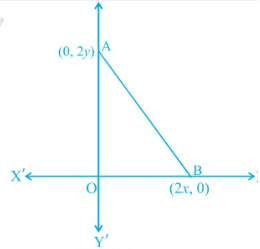MIDPOINT AND DISTANCE IN THE COORDINATE PLANE WORKSHEET
Subscribe to our ▶️ YouTube channel 🔴 for the latest videos, updates, and tips.
Problem 1 :
The point which lies on the perpendicular bisector of the line segment joining the points A(-2, -5) and B(2, 5) is
(A) (0, 0) (B) (0, 2) (C) (2, 0) (D) (-2, 0)
Problem 2 :
The fourth vertex D of a parallelogram ABCD whose three vertices are A(-2, 3), B(6, 7) and C(8, 3) is
(A) (0, 1) (B) (0, -1) (C) (-1, 0) (D) (1, 0)
Problem 3 :
If P(a/3, 4) is the midpoint of the line segment joining the points Q(-6, 5) and R(-2, 3), then the value of a is
(A) -4 (B) -12 (C) 12 (D) -6
Problem 4 :
The perpendicular bisector of the line segment joining the points A(1, 5) and B(4, 6) cuts the y-axis at
(A) (0, 13) (B) (0, -13) (C) (0, 12) (D) (13, 0)
Problem 5 :
The coordinates of the point which is equidistant from the three vertices of the Δ AOB.

(A) (x, y) (B) (y, x) (C) x/2, y/2 (D) y/2, x/2
Problem 6 :
A circle drawn with origin as the center passes through (13/2, 0). The point which does not lie in the interior of the circle is
(A) (-3/4, 1) (B) (2, 7/3)
(C) (5, -1/2) (D) (-6, 5/2)
Problem 7 :
A line intersects the y-axis and x-axis at the points P and Q, respectively. If (2, -5) is the mid-point of PQ, then the coordinates of P and Q are respectively
(A) (0, -5) and (2, 0) (B) (0, 10) and (-4, 0)
(C) (0, 4) and (-10, 0) (D) (0, -10) and (4, 0)
Problem 8 :
If the distance between the points (4, p) and (1, 0) is 5, then the value of p is
(A) 4 only (B) ± 4 (C) -4 only (D) 0
Answer Key
1) (0,0), option A
2) D(0, -1), option B
3) a=-12, option B
4) (0, 13), option A
5) (x, y), option A
6) (-6, 5/2) lies on the circle, option D
7) P (0, -10) and Q (4, 0), option D
8) p = ±4, option B
Subscribe to our ▶️ YouTube channel 🔴 for the latest videos, updates, and tips.
Recent Articles
-
Finding Range of Values Inequality Problems
May 21, 24 08:51 PM
Finding Range of Values Inequality Problems -
Solving Two Step Inequality Word Problems
May 21, 24 08:51 AM
Solving Two Step Inequality Word Problems -
Exponential Function Context and Data Modeling
May 20, 24 10:45 PM
Exponential Function Context and Data Modeling